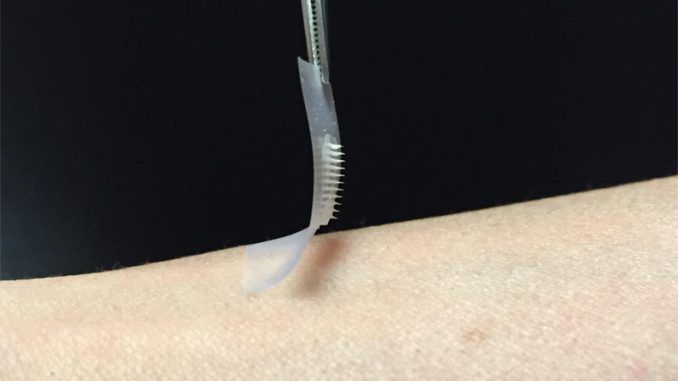
Painful insulin injections might soon become a thing of the past for millions of diabetics. Researchers have unveiled a smart patch that can automatically release insulin when needed.
The smart patch can monitor glucose levels and deliver insulin automatically via hundreds of micro-needles.
The high-tech device, which is small patch that sticks to the skin like a plaster, can detect even slight increases in blood sugar levels meaning that tiny doses of insulin can be given as and when it’s needed.

BYPASS THE CENSORS
Sign up to get unfiltered news delivered straight to your inbox.
You can unsubscribe any time. By subscribing you agree to our Terms of Use
The Mail Online report:
The patch – a thin square no bigger than a penny – is covered with more than one hundred tiny needles, each about the size of an eyelash.
These ‘microneedles’ are packed with microscopic storage units for insulin and glucose-sensing enzymes that rapidly release their cargo when blood sugar levels get too high.
The study, which is published in the Proceedings of the National Academy of Sciences, found that the new, painless patch could lower blood glucose in a mouse model of type 1 diabetes for up to nine hours.
More pre-clinical tests and subsequent clinical trials in humans will be required before the patch can be administered to patients, but the approach shows great promise.
‘We have designed a patch for diabetes that works fast, is easy to use, and is made from nontoxic, biocompatible materials,’ said co-senior author Zhen Gu.
‘The whole system can be personalized to account for a diabetic’s weight and sensitivity to insulin,’ he added, ‘so we could make the smart patch even smarter.’
Diabetes affects more than 387 million people worldwide, and that number is expected to grow to 592 million by the year 2035.
Patients with type 1 and advanced type 2 diabetes try to keep their blood sugar levels under control with regular finger pricks and repeated insulin shots, a process that is painful and imprecise.
John Buse, MD, PhD, co-senior author of the PNAS paper and the director of the UNC Diabetes Care Center, said, ‘Injecting the wrong amount of medication can lead to significant complications like blindness and limb amputations, or even more disastrous consequences such as diabetic comas and death.’
Gu and his colleagues chose to emulate the body’s natural insulin generators known as beta cells.
These versatile cells act both as factories and warehouses, making and storing insulin in tiny sacs called vesicles.
They also behave like alarm call centers, sensing increases in blood sugar levels and signaling the release of insulin into the bloodstream.
‘We constructed artificial vesicles to perform these same functions by using two materials that could easily be found in nature,’ said PNAS first author Jiching Yu, a PhD student in Gu’s lab.
The result was millions of bubble-like structures, each 100 times smaller than the width of a human hair.
Into each of these vesicles, the researchers inserted a core of solid insulin and enzymes specially designed to sense glucose.
In lab experiments, when blood sugar levels increased, the excess glucose crowded into the artificial vesicles.
The enzymes then converted the glucose into gluconic acid, consuming oxygen all the while. The resulting lack of oxygen or ‘hypoxia’ made the hydrophobic NI molecules turn hydrophilic, causing the vesicles to rapidly fall apart and send insulin into the bloodstream.
‘The hard part of diabetes care is not the insulin shots, or the blood sugar checks, or the diet but the fact that you have to do them all several times a day every day for the rest of your life, said Buse, the director of the North Carolina Translational and Clinical Sciences (NC TraCS) Institute and past president of the American Diabetes Association.
‘If we can get these patches to work in people, it will be a game changer.’


